| 1.仏像関係 |
| 1 |
阿弥陀如来 |
Amida Nyorai |
The Buddha who reside in the Western Pure Land. "He" made 48 vows to save sentient beings and is the main target of worship in the Jodo sect. It is believed that the faith in Amida will be reborn in the Western Pure Land after death. |
- |
| 2 |
月光菩薩 |
Gakko Bosatsu |
One of the two attendants of Yakushi Nyorai. "He" symbolizes moon light. |
- |
| 3 |
観音菩薩 |
Kannon Bosatsu |
One who observes the sound of the world: "she" listens to the faith's cries and save them with great compassion. Kannon is depicted as a female deity, known as the Goddess of Mercy. She is one of the two attendants of Amida Nyorai, the other being Seishi Bosatsu. |
- |
| 4 |
鬼子母神 |
Kishimojin |
Kishimojin is regarded as a god of child-rearing and easy child delivery. Once "she" was a female ogre and fed her one thousand children human fresh. Later, however, she repented her sins and became a guardian deity of children. |
- |
| 5 |
子育て地蔵 |
kosodate Jizo |
Child-raising Jizo |
- |
| 6 |
五大明王 |
Godai Myoo |
The Five Kings of Wisdom: Fudo Myoo, Gozanze Myoo, Daiitoku Myoo, Gundari Myoo, and Kongoyasha Myoo |
- |
| 7 |
五百羅漢 |
gohyakurakan |
Five hundred enlightened priests given the title of Arhat |
- |
| 8 |
三十三観音 |
Sanjusan Kannon |
Thirty-three Kannons. Kannon, who vows to save all sentient beings, appears in an appropriate form for the circumstance, selecting among the 33 manifestations. |
- |
| 9 |
三世仏 |
sanzebutsu |
Buddha in the three worlds: the past (阿弥陀Amida), present (釈迦Shakyamuni) and future (弥勒Miroku) |
- |
| 10 |
三宝祖師 |
sambososhi |
The three main objects of worship in the Nichiren sect: a tablet with the title of the Lotus Sutra(Namu-Myoho-renge-kyo), and the images of Shaka Nyorai and Taho Nyorai |
- |
| 11 |
地蔵(菩薩) |
Jizo Bosatsu |
The guardian deity mainly for children. "He"is also believed the guadian of pregnant women and travelers. He is so popular that various kinds of prayers are offered. |
- |
| 12 |
七福神 |
Shichifukujin |
The Seven Gods of Good Fortune; they are said to bring wealth and long life: Fukurokuju (福禄寿), Jurojin (寿老人), Benzaiten (弁才天), Bishamonten (毘沙門天), Hotei (布袋), Daikokuten (大黒天), and Ebisu (恵比寿). Fukurokuju is the god of lomg life accompanied by a deer. Jurojin is the god of long life with a long head. Benzaiten is the god of water and music, playing the biwa, a kind of lute. Bishamonten is the god of good fortune, dressed in armor. Hotei is the god of good fortune with a potbelly. Daikokuten is the god of wealth on a straw rice bag. Ebisu is the god of wealth and fishing, holding a sea beam. |
- |
| 13 |
四天王 |
Shitenno |
The Four Heavenly Kings who protect the four directions: east, west, south, and north. The east is guaded by Jikokuten, the west by Komokuten, the south by Zochoten, and the north by Tamonten. |
- |
| 14 |
釈迦如来 |
Shaka Nyorai |
The Buddha Shakamuni. Siddhartha Gautama himself, the founder of Buddhism, who attained the enlightenment. Shakanyorai is often the main target of worship in the Zen sect. |
- |
| 15 |
釈迦十大弟子 |
Shaka judaideshi |
Shakyamuni's ten best disciples |
- |
| 16 |
十一面観音 |
Juichimen Kannon |
The eleven-headed or eleven-faced Kannon, so called because of the ten or eleven small heads on "her" head. The small faces have different expressions: mercy, anger, jeer, and so forth. |
- |
| 17 |
十王像 |
Juozo |
Images of the ten king judges of Hell |
- |
| 18 |
十二神将 |
Juni Shinsho |
The Twelve Guardian Generals/ the Twelve Divine Generals |
- |
| 19 |
十六羅漢 |
jyuroku rakan |
The major sixteen enlightened disciples (Arhats) of Shakyamuni |
- |
| 20 |
聖観音 |
Sho-Kannon |
The Holy Kannon: one of the six manifestations of Kannon and is believed to save mainly hungry spirits. |
- |
| 21 |
勢至菩薩 |
Seishi Bosatsu |
One of the two attendants of Amida Nyorai. As the right-hand attendant of Amida Nyorai, "he" symbolizes wisdom, while the left-hand attendant Kannon represents mercy. |
- |
| 22 |
千手観音 |
Senju Kannon |
One thousand-armed/-hand Kannon. So many hands with an eye on the palm of each demonstrates her limitless saving ability. |
- |
| 23 |
大日如来 |
Dainichi Nyorai |
Dainichi is the embodiment of (the truth of) the universe itself and the central Buddha in the Shingon sect.. |
- |
| 24 |
天部 |
Tembu |
Deities who reside in a heavenly realm, one of six realms in which the souls of living beings transmigrate from one to another: hell, the worlds of hungry spirits, animals, asuras, men, and heaven. Taishakuten, Shitenno, |
- |
| 25 |
仁王 |
Nio |
The two Deva Kings who stand guard at the Buddhist temple gate. One statue opens his mouth, saying "a," meaning the first in Sanskrit alphabet, while the other closes mouth, saying "um," meaning the last. |
- |
| 26 |
日光菩薩 |
Nikko Bosatsu |
One of the two attendants of Yakushi Nyorai. "He" symbolizes sun light. |
- |
| 27 |
如来 |
Nyorai |
One who has finished an ascetic practices and attained enlightenment or Buddhahood. "One who has gone thus." Shaka Nyorai, Amida Nyorai, Yakushi Nyorai and Dainichi Nyorai are among others. |
- |
| 28 |
不動明王 |
Fudo Myoo |
The one immovable. Determined to subjugate evil spirits and guide evil-minded person to the realization of truth, "he" assumes a frightful face and form with a sword in his right hand and a rope in his left. |
- |
| 29 |
菩薩 |
Bosatsu |
One who seeks enlightenment not only for "himself/ herself" but for others. Prolonging to attain Buddhahood, one, out of compassion, makes vows to save suffering beings. Kannon Bosatsu, Seishi Bosatsu, Jizo Bosatsu are among others. |
- |
| 30 |
身代り地蔵 |
Migawari Jizo |
A substitute Jizo/ Jizo who substitutes himself for the suffering/ a substitute-for-the-suffering Jizo |
- |
| 31 |
明王 |
Myoo |
Deities who protect the Buddhists and Buddhism itself from evil effects. They usually have fierce lookings armed with some sorts of weapons. |
- |
| 32 |
薬師如来 |
Yakushi Nyorao |
The Healing Buddha/ Known as the Buddha of Healing, "he" resides in the World of Pure Emerald in the East. He usually has a medicine pot in his hand and is believed to cure diseases. |
- |
| 33 |
(五百)羅漢 |
Gohyaku-rakan |
Five hundred Arhats |
- |
| 34 |
羅漢 |
Rakan |
The enlightened disciples (Arhats) of Shakyamuni |
- |
| 35 |
脇侍 |
wakiji |
An attendant |
- |
| 3.寺院建築関連 |
| 1 |
阿弥陀堂 |
Amidado |
An Amida hall |
- |
| 2 |
開山堂/昭堂 |
kaisando/ shodo |
Founder's hall/ a hall where an image of the founder of a temple and his mortuary tablet are housed/ the term, shodo, is used in the Zen sect |
- |
| 3 |
花頭窓 |
katomado |
An arched window/ a bell-shaped window |
- |
| 4 |
唐破風 |
karahafu |
A Chinese style curved gable |
- |
| 5 |
唐様 |
karayo |
Chinese style |
- |
| 6 |
唐門 |
karamon |
A seemingly Chinese style gate with a curved, gabled roof (actually not Chinese but Japanese in origin) |
- |
| 7 |
客殿 |
kyakuden |
A guest hall |
- |
| 8 |
経蔵 |
kyozo |
A sutra repository |
- |
| 9 |
庫裏 |
kuri |
The priest's living quarters or the kitchen of a temple |
- |
| 10 |
講堂 |
kodo |
A lecture hall |
- |
| 11 |
金堂/ 本堂 |
kondo/ hondo |
A main hall |
- |
| 12 |
参道 |
sando |
An approach (to a shrine), an entrance path (to...) |
- |
| 13 |
山門 |
sanmon |
"The gate of a temple. It stands between the somon gate and the main hall. This gate is compared to an entrance to the three stages of emancipation (san gedatsu, 三解脱): 1. meditation on the non-substantiality of self (kumon, 空門), 2. meditation on the fact that visible phenomena do not really exist, because they are non-substantial, so there are no essential differences among them (musomon, 無相門), and 3. meditation on the fact that there is nothing to be desired, because of the unreality of phenomena (musamon, 無作門)
(This part is unfinished.)" |
- |
| 14 |
食堂 |
jikido |
A dining hall/ a refectory |
- |
| 15 |
地蔵堂 |
Jizodo |
A Jizo hall/ a hall deditaed to Jizo Busatsu |
- |
| 16 |
七堂伽藍 |
shichidogaran |
The seven major structures in a temple compound. What they are depend on the Buddhist sect. In the Zen sect the following structures are included: sammon gate (三門), butsuden (仏殿, Buddha hall), hatto(法堂, lecture hall), sodo (僧堂, meditation hall),kuin or kuri (庫院,庫裏(裡) temple's office or a kitchen), yokushitsu (浴室, bathroom), tosu (東司, toilet) , seichin, seijin or seijo (西浄, toilet). |
- |
| 17 |
祠堂 |
shido |
A hall dedicated to the souls of ancestors |
- |
| 18 |
寺務所 |
jimusho |
A temple office |
- |
| 19 |
舎利殿 |
Shariden hall |
A relic hall/ a hall for a bone of the Buddha |
- |
| 20 |
鐘楼 |
shoro |
A bell tower/ a bell platform/ a belfry |
- |
| 21 |
西浄 |
seichin, seijin or seijo |
A lavatory or toilet |
- |
| 22 |
選仏場 |
senbutsudo |
A hall for meditation |
- |
| 23 |
僧堂 |
sodo |
A hall for meditation |
- |
| 24 |
像鼻 |
zobana |
Literally, "an elephant's nose"; the end of a bar in the shape of an elephant's nose projecting from the outer side of a pillar |
- |
| 25 |
僧坊 |
sobo |
Monks' lodging house/ a dormitory |
- |
| 26 |
総門 |
somon gate |
The main gate of a temple, also called daimon/ an outer gate/ a outer front gate |
- |
| 27 |
祖師堂 |
soshido |
A founder's hall |
- |
| 28 |
塔頭 |
tacchu, or sub-temple |
(1)Originally a pagoda or a hall served by disciples, who follow their celebrated priest's teachings, as well as praise his honor and virtue, even after he has passed away.Later a celebrated priests become semiindependent, and have their own hall, together with many disciples, which continues as a sub-temple even after his death. (2)A minor hall in the grounds of a Zen temple, where the retired head priest lives. |
- |
| 29 |
中門 |
chumon |
An inner gate |
- |
| 30 |
内陣 |
naijin |
An inner sanctuary |
- |
| 31 |
仁王門 |
Niomon |
A gate guarded by the two Deva Kings: Misshaku Kongo(left) and Naraen Kongo(right)/ a Deva gate where two Deva Kings guard: |
- |
| 32 |
二重門 |
nijumon |
A two-storied gate |
- |
| 33 |
二天門 |
Nitenmon |
A gate guarded by the two guardian Kings: Jikokuten and Bishamonten(or Tamonten.) |
- |
| 34 |
袴腰 |
hakamagoshi |
The lower part of a structure expanding wider like hakama, loose trousers worn over a kimono as a part of formal dress |
- |
| 35 |
法堂 (=講堂) |
hatto |
A lecture hall (of a Zen temple) |
- |
| 36 |
廟所 |
byosho |
A mausoleum |
- |
| 37 |
札所 |
fudasho |
①A temple's office that issues amulets ②A temple regularly visited by pilgrims |
- |
| 38 |
仏殿 |
butsuden |
A Buddha hall/ a hall which houses Buddhist images/ In Zen temples, the central hall that houses the main Buddhist image is called butsuden |
- |
| 39 |
方丈 |
hojo |
A head priest's living quarters |
- |
| 40 |
宝蔵庫 |
hozoko |
A treasure house (hall) |
- |
| 41 |
本堂 |
hondo |
A main hall |
- |
| 42 |
棟札 |
munafuda |
A plate attached to a building with the date of completion, the names of the founders and carpenters, and so forth |
- |
| 43 |
楼門 |
romon |
A two-storied gate without a roof on the first story |
- |
| 4.仏教関連その他 |
| 1 |
位牌 |
ihai |
A mortuary tablet |
- |
| 2 |
雲版 |
umpan |
A bronze plate shaped like a cloud, which is hit to give signals for meals and other events, hung on a wall in a temple. |
- |
| 3 |
開基 |
kaiki |
A patron of a temple in its founding |
- |
| 4 |
開山 |
kaisan |
The founder of a temple |
- |
| 5 |
学問所(寺) |
gakumonsho |
An academic temple |
- |
| 6 |
鎌倉五山 |
kamakura gozan |
The Five Zen Temples in Kamakura: Kenchoji (建長寺), Engakuji (円覚寺), Jufukuji (寿福寺), Jochiji (浄智寺), and Jomyoji (浄妙寺). |
- |
| 7 |
関東十刹 |
Kanto jissetsu/ Kanto jissatsu |
The ten major Zen temples in the Kanto region under the Kamakura Gozan("the Five Temples"): 禅興寺, 瑞泉寺, 東勝寺, 万寿寺, 大慶寺, 興聖寺, 東漸寺, 善福寺, 法泉寺, 長楽寺 |
- |
| 8 |
供養 |
kuyo |
A memorial service for somebody's soul |
- |
| 9 |
懸盤 |
keban |
A hanging board with the image of the Buddha |
- |
| 10 |
懸仏 |
kebutsu |
A hanging Buddha |
- |
| 11 |
五鈷杵 |
gokosho |
A five-pronged pounder |
- |
| 12 |
五鈷鈴 |
gokorei |
A five-pronged bell |
- |
| 13 |
山号 |
sango, a prefix of a temple |
Essentially a temple should be built at a spot separated from worldly areas (e.g. on a mountain or a hillside, etc.) So a temple has a prefix of so and so san(山, mountain) prior to its name |
- |
| 14 |
錫杖 |
shakujo |
A walking staff with a clanking bell or a staff of office |
- |
| 15 |
須弥壇 |
shumidan |
A wooden stand on which statues are set in a Buddha hall/ a square platform with low railings mounted on a multi-stepped base, often decorated with Buddhist motifs |
- |
| 16 |
施餓鬼 |
segaki |
A Buddhist service for the repose of the dead |
- |
| 17 |
禅師号 |
zenji-go |
The title of Zen Master |
- |
| 18 |
題目(日蓮宗) |
daimoku |
The title of the Lotus Sutra, Namu Myoho renge kyo, recited by Nichiren sect believers |
- |
| 19 |
中興開基 |
chuko kaiki |
A priest who restored a temple and was honored like its founder |
- |
| 20 |
勅願寺 |
chokuganji |
A temple built according to an emperor's order |
- |
| 21 |
辻説法 |
tsujiseppo |
Street preaching/ preaching on the street |
- |
| 22 |
塔婆/ 卒塔婆 |
toba/ sotoba |
Stupa: a tall, narrow wooden tablet for the repose of the dead, having the silhouette of gorinto(a "five-wheel" pagoda) |
- |
| 23 |
南無阿弥陀仏 |
Namu Amida Butsu |
I take my refuge in the Buddha Amida |
- |
| 24 |
廃仏毀釈 |
haibutsu kishaku |
The movement for abolishment of Buddhism |
- |
| 25 |
法名 |
homyo |
A Buddhist name after one retired into religion or a posthumous name(戒名) |
- |
| 26 |
払子 |
hossu |
A short staff with a tail-like brush |
- |
| 27 |
本山 |
honzan |
The head temple |
- |
| 28 |
末寺 |
matsuji |
A sub-temple |
- |
| 29 |
輪宝 |
rimbo |
A stylized ancient Indian wheel which is said to drive away evil |
- |
| 30 |
蓮弁 |
remben |
Petals of a lotus flower/ (a) lotus petal(s) |
- |
| 31 |
六道 |
rokudo |
The six paths to the six realms along which souls of sentient beings transmigrate: hell (jigoku,地獄), hungry spirits(gaki,餓鬼), animals(chikusho,畜生), bellicose spirits (ashura,阿修羅), human beings (ningen,人), and heaven (ten,天) |
- |
| 32 |
鰐口 |
waniguchi |
Literally, a "crocodile's mouth", a metal drum hung above the entrance to the main hall of a temple; one announces one's presence by hitting it with a bundle of ropes |
- |
| 5.石塔関連 |
| 1 |
板碑 |
itabi |
A flat stone stupa in memory of the departed with the Buddha image or characters symbolizing the Buddha on it |
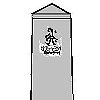 |
| 2 |
逆修塔 |
gyakushuto |
A stupa or pagoda built prior to one's death |
- |
| 3 |
供養塔 |
kuyoto |
A pagoda erected for the repose of one's soul |
- |
| 4 |
庚申塔 |
koshinto |
A small stone monument built based on the folk belief in koshin. On the night designated the day of koshin (one of 60 set of days in old tradition) three worms lurking in one's body creep out and tell one's wrongdoings to the God in Heaven. People stayed awake until dawn to prevent their tip-off . |
 |
| 5 |
五輪塔 |
Gorinto, literally 'five-wheel pagoda' |
A kind of stupa composed of five different shapes of stones( or wood) stacked one on top of another; from bottom to top, they symbolize the five universal elements: earth, water, fire, wind, and sky (emptiness) |
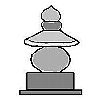 |
| 6 |
多層塔 |
tasoto |
A multi-storied stupa/ a multi-tiered stupa |
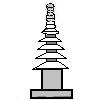 |
| 7 |
多宝塔 |
tahoto |
A "multi-treasure" pagoda |
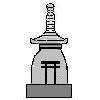 |
| 8 |
宝篋印塔 |
hokyointo |
Hokyoin pagoda, originally a pagoda in which the sutra of Hokyoin-darani-kyo was stored, and later hokyoin pagodas were built to repose the soul of the deadHokyoin-darani-kyo(sutra) states that if one chants this sutra, one can bring a person in hell up to paradise |
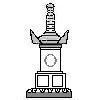 |
| 9 |
無縫塔(卵塔) |
muhoto(ranto) |
Literally a pagoda without joints. A pagoda made of a single stone in the shape of an egg; often used as the tomb stone of a Zen monk |
 |
| 6.神社・神道関連 |
| 1 |
神楽 |
kagura |
Sacred music and dancing performed at shrines |
- |
| 2 |
神楽殿 |
kaguraden hall |
A hall for sacred Shinto music and dancing |
- |
| 3 |
鰹木 |
katuogi |
Short logs that lie horizontally across the ridge of the Shinto structures |
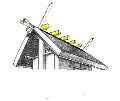 |
| 4 |
勧請 |
kanjo |
To devide the spirit of god and build a new shrine dedicated to it |
- |
| 5 |
狛犬 |
komainu |
A pair of Korean dogs in a shrine grounds |
- |
| 6 |
権現造 |
gongen-zukuri |
A structure of Shinto shrine: a main hall and a worship hall are separate but connected by a small hall called ishi no ma or nusaden
|
 |
| 7 |
神仏混交 |
shinbutsu konko |
Mixture of Shintoism and Buddhism |
- |
| 8 |
神仏分離 |
shinbutsu bunri |
The separation of Shintoism and Buddhism/ the Meiji government policy of separating Shinto and Buddhism in favor of the former |
- |
| 9 |
神明鳥居 |
shinmei torii |
A Shimmei-style torii, where the two columns stand straight and the horizontal bars are straight, too |
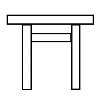 |
| 10 |
千木 |
chigi |
Ornamental cross planks (arranged in an X-shape) and extended high above the both gables |
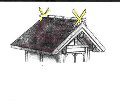 |
| 11 |
鳥居 |
torii |
A gateway to a Shinto shrine |
- |
| 12 |
流造 |
nagare-zukuri |
A style of a shrine structure characterized by the flowing lines of the roof which extends down over an entrance |
 |
| 13 |
幤殿, 石の間 |
nusaden |
A hall connecting a main hall to a hall of worship in the gongen-zukuri style shrine structure |
- |
| 14 |
祝詞舎 |
noritoya |
A hall for Shinto prayer |
- |
| 15 |
拝殿 |
haiden |
A hall of worship/ an oratory |
- |
| 16 |
八幡造 |
hachiman-zukuri |
The Hachiman style, a kind of a shrine structure; it has a main hall and an oratory ( or a hall of worship) connected by a hall called ishinoma (See ishinoma) |
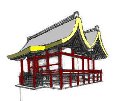 |
| 17 |
祠 |
hokora |
A small Shinto shrine |
- |
| 18 |
本殿 |
honden |
A main hall/ main sanctuary |
- |
| 19 |
舞殿 |
maiden |
A hall for sacred dance and music |
- |
| 20 |
末社 |
massha |
A sub-shrine/ a subordinate shrine |
- |
| 21 |
神輿 |
mikoshi |
A portable shrine |
- |
| 22 |
明神鳥居 |
myojin torii |
A Myojin-style torii, the most popular one where two columns stand leaning slightly inside with an upper bar which curves upward on both sides |
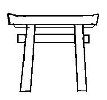 |
| 8.組織・役名関連 |
| 1 |
鎌倉御所 |
Kamakura gosho |
The Kanto headquarters (in Kamakura) of the Muromachi bakufu |
- |
| 2 |
鎌倉公方/ 関東公方 |
Kamakura kubo/ Kanto kubo |
Governor-general of the Kanto region |
- |
| 3 |
鎌倉府 |
Kamakurafu |
A branch office of the Muromachi bakufu in Kamakura / the Kanto headquarters of the Muromachi bakufu |
- |
| 4 |
鎌倉幕府 |
Kamakura bakufu |
The Kamakura shogunate |
- |
| 5 |
関東管領 |
Kanto kanrei |
A shogunal deputy for the Kanto region |
- |
| 6 |
関東将軍 |
Kanto shogun |
A Kanto shogunate/ a shogun the in the Kanto region |
- |
| 7 |
官衙 |
kanga |
Local government offices |
- |
| 8 |
京都守護 |
the Kyoto shugo |
Kyoto military governor |
- |
| 9 |
国 |
kuni |
Province/ province |
- |
| 10 |
公問所 |
the Kumonjo |
The Public Documents Office |
- |
| 11 |
御家人 |
gokenin |
An immediate vasal of the shogunate in the Kamakura and Muromachi through Edo periods. |
- |
| 12 |
左大臣 |
sadaijin |
Minister of the Left |
- |
| 13 |
侍所 |
the Samurai-dokoro |
The Board of Retainers |
- |
| 14 |
執権 |
shikken |
A (shogunal) regent/ regency/ the Hojo regency |
- |
| 15 |
執事 |
shitsuji |
A steward |
- |
| 16 |
地頭 |
jito |
A land steward |
- |
| 17 |
守護 |
shugo |
A constable |
- |
| 18 |
将軍 |
shogun |
(An abbreviation of seii tai shogun) 将軍職:shogunate |
- |
| 19 |
寺領 |
jiryo |
Temple's estate/ land/ ground |
- |
| 20 |
征夷大将軍 |
seii tai shogun |
Literally, barbarian-subduing generalissimo |
- |
| 21 |
探題 |
tandai |
Shogunal deputies, officials appointed in strategic areas by the Kamakura and Muromachi shogunates to oversee political, military, and judicial affairs |
- |
| 22 |
得宗 |
tokuso |
The patrimonial head of the main branch of the Hojo clan. The term came from the Buddhist name of Hojo Yoshitoki, the second regent, who consolidated the political power of his family |
- |
| 23 |
幕府 |
bakufu |
Literally, a "tent government"/ the feudal government/ the shogunate |
- |
| 24 |
引付 |
Hikitsuke |
The High Court |
- |
| 25 |
引付衆 |
hikitsukeshu |
Coadjustor of the High Court |
- |
| 26 |
評定衆 |
Hyojoshu |
The Council of State |
- |
| 27 |
侍所別当 |
samuraidokoro betto |
An administrator of the Board of Retainers |
- |
| 28 |
別当 |
betto |
①An administrator ②A head priest |
- |
| 29 |
政所 |
mandokoro |
The Administrative Board |
- |
| 30 |
問注所 |
monchujo |
The Board of Inquiry |
- |
| 31 |
六波羅探題 |
rokuhara tandai |
Rokuhara deputies |
- |
| 9.資料・書籍関連 |
| 1 |
吾妻鏡 |
Azuma kagami |
Mirror of Eastern Japan |
- |
| 2 |
院宣 |
inzen |
A command issued by an ex-Emperor |
- |
| 3 |
鎌倉攬勝考 |
Kamakura ransho ko |
The geographical description of Kamakura's historic and scenic sites |
- |
| 4 |
勧進状 |
kanjinjo |
A letter asking for contributions |
- |
| 5 |
起請文 |
kishomon |
A written oath |
- |
| 6 |
寄進状 |
kishinjo |
A letter of donation |
- |
| 7 |
喫茶養生記 |
Kissa-yojoki |
Drink Tea and Prolong Life/ A Note on Drinking Green Tea for Good Health / A Note on the Efficacy of Drinking Green Tea for Good Health |
- |
| 8 |
考古資料 |
koko shiryo |
Archaelogical specimens/ evidence |
- |
| 9 |
御成敗式目 |
Goseibai Shikimoku |
The Formulary of Administration established by the Kamakura Shogunate for its vassals in 1232 |
- |
| 10 |
古都保存法 |
kotohozon-ho |
The Ancient Capital Preservation Law |
- |
| 11 |
古文書 |
komonjo |
Ancient documents |
- |
| 12 |
赦免状 |
shamenjo |
a (letter of) pardon ( issued by the Kamakura bakufu) |
- |
| 13 |
書跡 |
shoseki |
Calligraphic works/ calligraphy |
- |
| 14 |
宸筆 |
shinpitsu |
Letters written by an emperor/ empress |
- |
| 15 |
新編鎌倉誌 |
Shimpen Kamakura shi |
New Records of the Culture and Geography of Kamakura/ The Newly Compiled Topography of Kamakura by Mito Mitsukuni/A kind of chronicle including scenic spots and places of historic interest in Kamakura, published in the Edo period |
- |
| 16 |
新編相模国風土記稿 |
Shimpen Sagami no Kuni fudoki ko |
A New Draft of Sagami no kuni fudoki: Fudoki is a report on the natural resouces, geophysical conditions, customs, culture, and economic life in a certain district |
- |
| 17 |
地誌 |
chishi |
A (local) topography, a geographical description |
- |
| 18 |
触書 |
furegaki |
An announcement by the government |
- |
| 19 |
義経腰越状 |
Yoshitsune Koshigoe jo |
Yoshitsune's letter sent from Koshigoe |
- |
| 20 |
立正安国論 |
Rissho ankoku ron |
A Treatise on Pacifying the State by Establishing Orthodoxy |
- |
| 21 |
令旨 |
ryoji |
Orders issued by princes, empresses, and etc. |
- |
| 22 |
歴史資料 |
rekishi shiryo |
Historical materials |
- |













